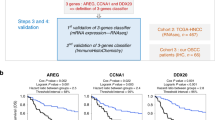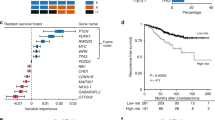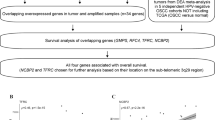Abstract
The prognosis of oral squamous cell carcinoma (OSCC) patients remains poor without implemented biomarkers in the clinical routine practice to help in the patient’s management. With this study we aimed to identify specific prognostic biomarkers for OSCC using a whole genome technology as well as to verify the clinical utility of a head and neck cancer-specific multiplex ligation-dependent probe amplification (MLPA) panel. A genomic characterization of tumor samples from 62 OSCC patients was performed using array comparative genomic hybridization (aCGH) and a more straightforward and cost-effective molecular technology, MLPA. The identification of a genomic signature and prognosis biomarkers was carried out by applying several statistical methods. With aCGH we observed that the chromosomes most commonly altered were 3p, 3q, 5q, 6p, 7q, 8p, 8q, 11q, 15q, 17q, and 18q. The MLPA results showed that the chromosomes with a higher frequency of alterations were 3p, 3q, 8p, 8q, and 11q. We identified a genomic signature with seven genes OCLN (3p21.31), CLDN16 (3q29), SCRIB (3q29), IKBKB (3q22.3), PAK2 (8q22.3), PIK3CB (3q28), and YWHAZ (8q24.3) that together allow to differentiate the patients that developed metastases or relapses after primary tumor treatment, with an overall accuracy of 79%. Amplification of PIK3CB as a predictor of metastases or relapses development was validated using TCGA data. This amplified gene showed a reduction in more than 5 years in the median survival of the patients. The identified biomarkers might have a significant impact in the patients’ management and could leverage the OSCC precision medicine.
This is a preview of subscription content, access via your institution
Access options
Subscribe to this journal
Receive 50 print issues and online access
$259.00 per year
only $5.18 per issue
Buy this article
- Purchase on Springer Link
- Instant access to full article PDF
Prices may be subject to local taxes which are calculated during checkout






Similar content being viewed by others
Data availability
The data from array-CGH analyses that support the findings of this study are openly available at https://apps.uc.pt/mypage/faculty/fcaramelo/en/oscc.
References
Gilyoma JM, Rambau PF, Masalu N, Kayange NM, Chalya PL. Head and neck cancers: a clinico-pathological profile and management challenges in a resource-limited setting. BMC Res Notes. 2015;8:772.
Chatterjee A, Laskar SG, Chaukar D. Management of early oral cavity squamous cancers. Oral Oncol. 2020;104:104627.
Braakhuis BJ, Brakenhoff RH, Leemans CR. Second field tumors: a new opportunity for cancer prevention? oncologist. 2005;10:493–500.
Leemans CR, Tiwari R, Nauta JJ, van der Waal I, Snow GB. Regional lymph node involvement and its significance in the development of distant metastases in head and neck carcinoma. Cancer. 1993;71:452–6.
Leemans CR, Tiwari R, Nauta JJ, van der Waal I, Snow GB. Recurrence at the primary site in head and neck cancer and the significance of neck lymph node metastases as a prognostic factor. Cancer. 1994;73:187–90.
Li Y, Cao X, Li H. Identification and validation of novel long non-coding RNA biomarkers for early diagnosis of oral squamous cell carcinoma. Front Bioeng Biotechnol. 2020;8:256.
Pantvaidya G, Rao K, D’Cruz A. Management of the neck in oral cancers. Oral Oncol. 2020;100:104476.
Ribeiro IP, Barroso L, Marques F, Melo JB, Carreira IM. Early detection and personalized treatment in oral cancer: the impact of omics approaches. Mol Cytogenetics. 2016;9:85.
Ribeiro IP, Caramelo F, Esteves L, Menoita J, Marques F, Barroso L, et al. Genomic predictive model for recurrence and metastasis development in head and neck squamous cell carcinoma patients. Sci Rep. 2017;7:13897.
Zhong L, Liu Y, Wang K, He Z, Gong Z, Zhao Z, et al. Biomarkers: paving stones on the road towards the personalized precision medicine for oral squamous cell carcinoma. BMC Cancer. 2018;18:911.
Altman DG. Practical statistics for medical research. Chapman & Hall/CRC; London, 1991.
Vincent-Chong VK, Salahshourifar I, Woo KM, Anwar A, Razali R, Gudimella R, et al. Genome wide profiling in oral squamous cell carcinoma identifies a four genetic marker signature of prognostic significance. PLoS ONE. 2017;12:e0174865.
Ribeiro IP, Marques F, Caramelo F, Pereira J, Patricio M, Prazeres H, et al. Genetic gains and losses in oral squamous cell carcinoma: impact on clinical management. Cell Oncol. 2014;37:29–39.
Gupta A, Ajith A, Singh S, Panday RK, Samaiya A, Shukla S. PAK2-c-Myc-PKM2 axis plays an essential role in head and neck oncogenesis via regulating Warburg effect. Cell Death Dis. 2018;9:825.
Barrow J, Adamowicz-Brice M, Cartmill M, MacArthur D, Lowe J, Robson K, et al. Homozygous loss of ADAM3A revealed by genome-wide analysis of pediatric high-grade glioma and diffuse intrinsic pontine gliomas. Neuro Oncol. 2011;13:212–22.
Jeong S, Yoo EJ, Kim JY, Han CW, Kim KJ, Kay CS. Re-irradiation of unresectable recurrent head and neck cancer: using Helical Tomotherapy as image-guided intensity-modulated radiotherapy. Radiat Oncol J. 2013;31:206–15.
Jung AC, Job S, Ledrappier S, Macabre C, Abecassis J, de Reynies A, et al. A poor prognosis subtype of HNSCC is consistently observed across methylome, transcriptome, and miRNome analysis. Clin Cancer Res: Off J Am Assoc Cancer Res. 2013;19:4174–84.
Lui VW, Hedberg ML, Li H, Vangara BS, Pendleton K, Zeng Y, et al. Frequent mutation of the PI3K pathway in head and neck cancer defines predictive biomarkers. Cancer Discov. 2013;3:761–9.
Yang J, Nie J, Ma X, Wei Y, Peng Y, Wei X. Targeting PI3K in cancer: mechanisms and advances in clinical trials. Mol Cancer. 2019;18:26.
Al-Rawi N, Merza M, Ghazi A. PIK3CB and K-ras in oral squamous cell carcinoma. A possible cross-talk! J Orofac Sci. 2014;6:99–103.
Lin WH, Asmann YW, Anastasiadis PZ. Expression of polarity genes in human cancer. Cancer Inform. 2015;14:15–28.
Pierucci-Alves F, Yi S, Schultz BD. Transforming growth factor beta 1 induces tight junction disruptions and loss of transepithelial resistance across porcine vas deferens epithelial cells. Biol Reprod. 2012;86:36.
Kuo SJ, Chien SY, Lin C, Chan SE, Tsai HT, Chen DR. Significant elevation of CLDN16 and HAPLN3 gene expression in human breast cancer. Oncol Rep. 2010;24:759–66.
Page A, Navarro M, Suarez-Cabrera C, Bravo A, Ramirez A. Context-dependent role of IKKbeta in cancer. Genes. 2017;8:376.
Nishimura Y, Komatsu S, Ichikawa D, Nagata H, Hirajima S, Takeshita H, et al. Overexpression of YWHAZ relates to tumor cell proliferation and malignant outcome of gastric carcinoma. Br J Cancer. 2013;108:1324–31.
McGranahan N, Swanton C. Clonal heterogeneity and tumor evolution: past, present, and the future. Cell. 2017;168:613–28.
Gabusi A, Gissi DB, Montebugnoli L, Asioli S, Tarsitano A, Marchetti C, et al. Prognostic impact of intra-field heterogeneity in oral squamous cell carcinoma. Virchows Arch. 2020;476:585–95.
Ribeiro IP, Marques F, Caramelo F, Ferrao J, Prazeres H, Juliao MJ, et al. Genetic imbalances detected by multiplex ligation-dependent probe amplification in a cohort of patients with oral squamous cell carcinoma-the first step towards clinical personalized medicine. Tumour Biol. 2014;35:4687–95.
Acknowledgements
We thank MRC-Holland for the MLPA P428-B1 probe panel.
Author information
Authors and Affiliations
Corresponding author
Ethics declarations
Conflict of interest
The authors declare no competing interests.
Additional information
Publisher’s note Springer Nature remains neutral with regard to jurisdictional claims in published maps and institutional affiliations.
Supplementary information
Rights and permissions
About this article
Cite this article
Ribeiro, I.P., Esteves, L., Santos, A. et al. A seven-gene signature to predict the prognosis of oral squamous cell carcinoma. Oncogene 40, 3859–3869 (2021). https://doi.org/10.1038/s41388-021-01806-5
Received:
Revised:
Accepted:
Published:
Issue Date:
DOI: https://doi.org/10.1038/s41388-021-01806-5



